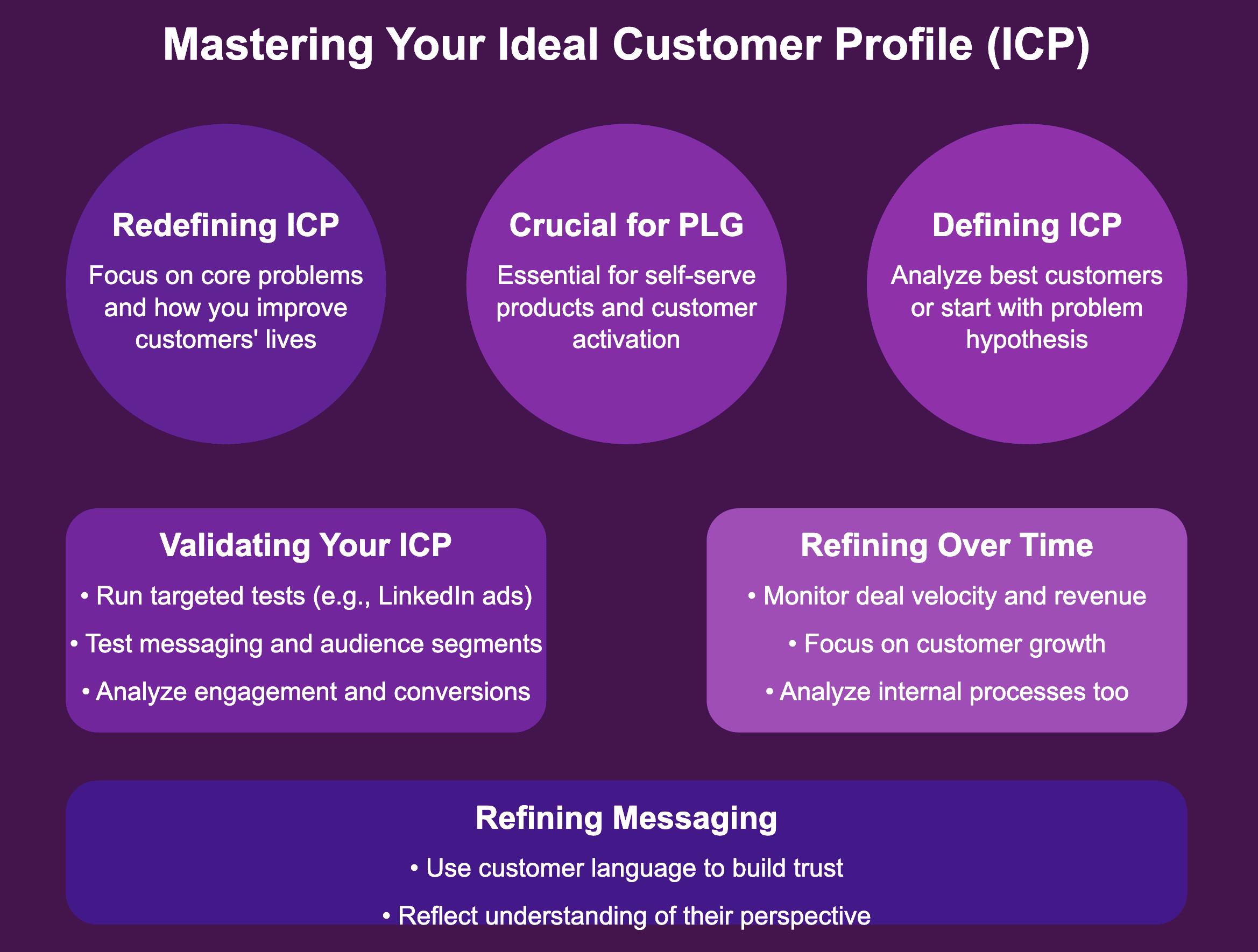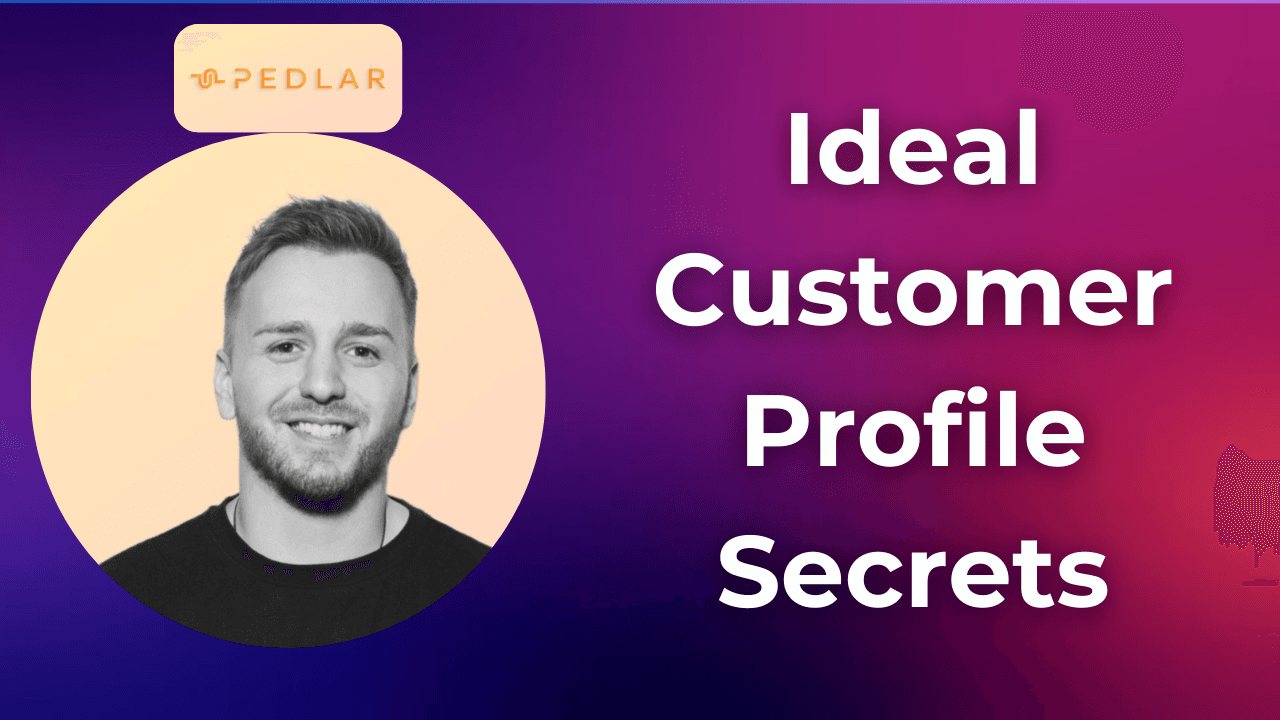
Ideal Customer Profile Secrets: Supercharge SaaS Growth

by
Aleksa Mitrović
Sep 8, 2024
Identify and convert your most valuable users
Sign Up
Up to 70% of SaaS startups fail within their first two years. One of the main reasons? They're targeting the wrong customers. Enter the Ideal Customer Profile (ICP) – a game-changer that could mean the difference between your startup joining the success stories or becoming another statistic.
But what exactly is an ICP, and how can you harness its power to drive sustainable growth? We recently had the privilege of sitting down with Marvin, a dynamic serial founder who has navigated the highs and lows of the startup world since 2017.
He founded his first SaaS company in 2017, scaling it to over 20 employees and raising significant venture capital. His hands-on experience in everything from building sales teams to crafting marketing strategies gives him a unique, holistic understanding of go-to-market motions.
Now, as a consultant for early-stage, venture-backed companies, Marvin helps businesses improve their marketing and sales efforts, with a particular focus on companies approaching or just past product-market fit. His expertise in building sustainable marketing channels and inbound funnels makes him the perfect guide for our deep dive into ICPs.
Redefining the Ideal Customer Profile

When most people think of an ICP, they often focus on demographics and basic criteria. However, Marvin challenges this conventional wisdom with a more nuanced approach. He emphasizes the importance of understanding the core problems your product addresses and how it fundamentally improves your customers' lives.
"To me, it's about more than just demographics or technocratic criteria," Marvin explains. "It's about understanding: What problems am I solving for my customers? How am I improving their lives? Who are these people that I'm actually doing this for? And in what kind of settings am I most likely to encounter them?"
This perspective shifts the focus from who your customers are to why they need your solution and how urgently they need it. It's a subtle but powerful change in approach that can dramatically impact your go-to-market strategy.
Marvin shared an intriguing observation about how many companies approach their ICP: "A lot of companies go and say, 'Okay, we want to target enterprise customers.' But when you dig deeper and ask why they chose these specific things, it often starts from an internal perspective without actually having validated that or scored that in terms of urgency for the customers in these industries."
This insight challenges us to think beyond surface-level characteristics and truly understand our customers' needs, motivations, and the urgency of their problems.
The Crucial Role of ICP in Product-Led Growth
For companies focusing on product-led growth (PLG), nailing your ICP becomes even more critical. Marvin pointed out that in PLG, you're often providing a self-serve product. If your target customers don't have an urgent need or if your product doesn't fit seamlessly into their workflow, you'll struggle to get them to sign up, activate, and implement your solution in their day-to-day lives.
"It's really important for PLG because that's exactly who you're looking for," Marvin emphasizes. "In PLG, you're often giving people a self-serve sort of product. If it's not a very urgent topic for them, or if it's not easy to understand, or maybe doesn't really fit the way they're used to doing a specific job, you're not going to be very successful in actually getting them to sign up, activate, and implement it in their day-to-day life."
Understanding your ICP helps you identify customers who not only fit your criteria but also have the intrinsic motivation to engage with your product and solve their problems. This is particularly crucial in a self-serve environment where customers need to recognize the value and implement the solution largely on their own.
Defining and Validating Your ICP
So, how do you start defining your ICP? Marvin suggests two main approaches, depending on your company's stage:
For companies with existing customers: Analyze your best customers – those generating the most revenue, showing the most growth, and being most active in your product. Look for patterns in their characteristics, behaviors, and the problems they're solving with your product.
For new companies without much data: Start with a hypothesis about the problem you're solving and who you're solving it for. Think about the urgency of the problem and who is most likely to need your solution.
To validate your ICP, Marvin recommends running targeted tests using platforms like LinkedIn ads. By creating specific audience segments and testing different messaging, you can gather valuable data on what resonates with your potential customers.
"LinkedIn ads are a great way to do this," Marvin explains. "You can run very targeted tests. I can say, 'Okay, I think this messaging should resonate with this persona inside this type of company.' I build an audience, define that audience, and start sending that message into their feeds."
He adds, "If people are clicking, engaging, maybe even converting to a lead, those are very good signals that you're on the right track. You can do the same with outbound emails and other channels too."
Refining Your ICP Over Time
As your business grows, your ICP should evolve. Marvin advises looking at metrics like deal velocity, revenue potential, and customer expansion over time. He emphasizes the importance of not just winning new customers, but growing existing ones, especially for SaaS businesses.
"It's important not just to be able to win a new customer, but actually to grow those customers, especially if you're a SaaS business," Marvin points out. "Take a land and expand approach. Start small and start building, especially if you're looking to move upmarket."
Interestingly, Marvin cautions against always blaming your ICP when things aren't working. Sometimes, the issue might be with your sales process or other internal factors. It's crucial to analyze your own processes before concluding that you've targeted the wrong market.
"Sometimes you have the right ICP, but your sales process is not working well," he warns. "So you might be thinking, 'Okay, maybe it's not my target group,' but you actually need to look at your own process, how you're handling these leads, and try to fix any gaps you have there. Only after you've done that can you really say, 'Okay, I think the market is the problem, not us.'"
The Art of Refining Messaging

One of the most fascinating parts of our conversation with Marvin was his insights on refining messaging to better resonate with your ICP. He stressed the importance of listening closely to how customers talk about their problems and your product. Often, there's a disconnect between how companies describe their product internally and how customers perceive it.
Marvin shared a valuable tip: "Use their own words to describe situations or scenarios or jobs to be done. It starts building a sense of 'Okay, they get me. They understand what my day-to-day looks like. They understand what issues I'm facing, why I'm facing them, why I care about solving them.' And that builds a little bit of trust because they seem to understand what they're talking about."
This approach to messaging goes beyond just using the right keywords. It's about truly understanding your customers' perspective and reflecting that understanding back to them in your communications. This builds trust and increases the likelihood that potential customers will engage with your product.
Wrapping Up
Our conversation with Marvin was filled with practical advice and thought-provoking insights on defining and refining your Ideal Customer Profile. From challenging traditional notions of what an ICP should be, to emphasizing the importance of customer language in messaging, Marvin's approach offers a fresh perspective on this crucial aspect of business strategy.
While we've covered some key points here, there's so much more to explore in the full interview. Marvin's wealth of experience as a serial founder and consultant shines through in his detailed explanations and real-world examples. His insights on topics like:
How to balance quantitative and qualitative data when refining your ICP
The role of different teams (marketing, sales, product) in managing the ICP
Specific strategies for testing and iterating on your messaging
How to adapt your ICP approach as your company grows and evolves
...and much more, provide a comprehensive toolkit for any business looking to master their Ideal Customer Profile.
If you're intrigued by these insights and want to dive deeper into the world of ICPs, product-led growth, and effective messaging, we encourage you to check out the full interview with Marvin. You'll gain a more comprehensive understanding of these strategies and how to apply them to your own business.
Remember, mastering your Ideal Customer Profile is an ongoing journey. As Marvin puts it, "It's more art than science." But with the right approach and continuous refinement, you can create a powerful ICP that drives your business forward. Stay curious, keep experimenting, and never stop learning from your customers!





